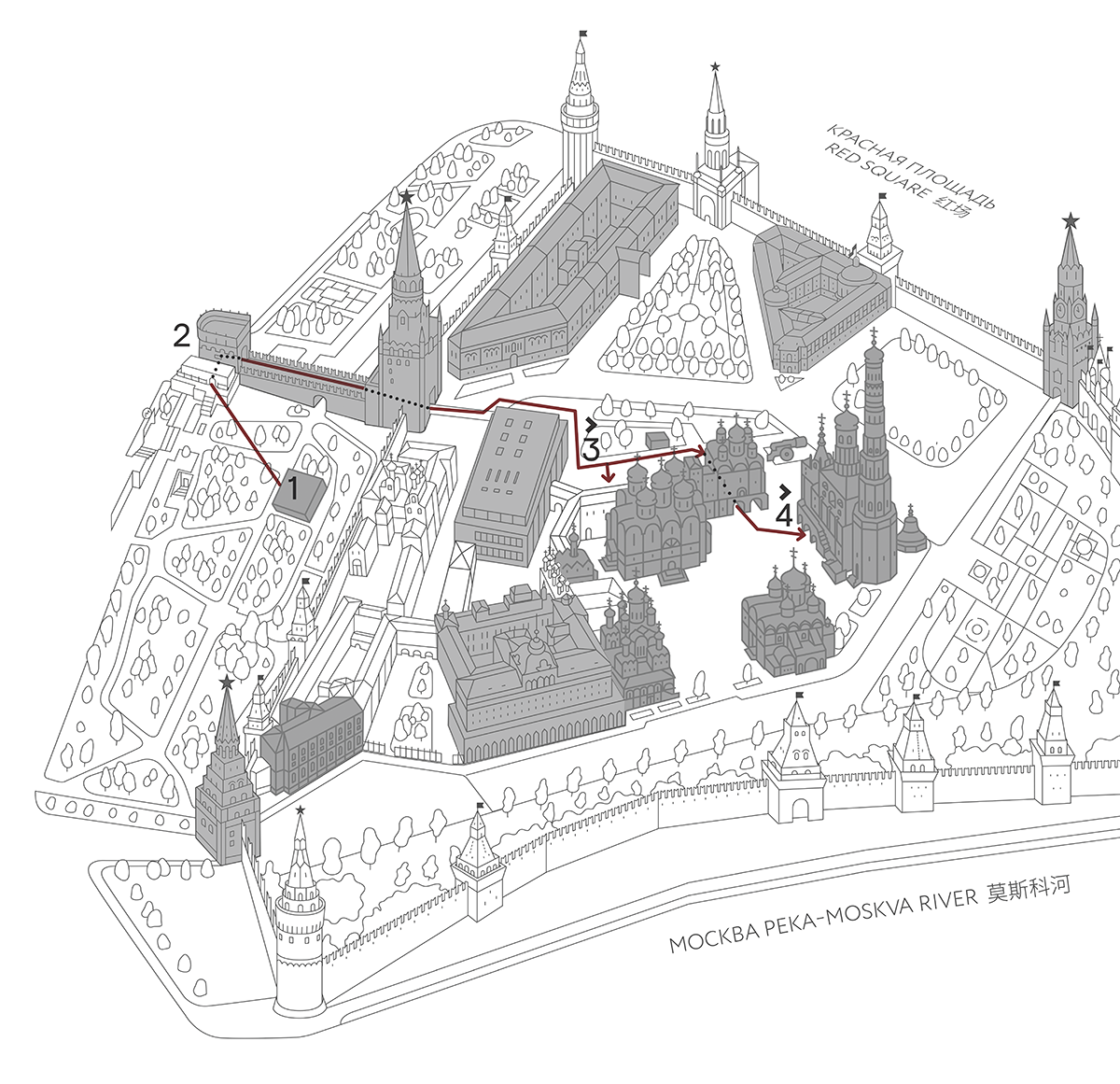Legends surrounded the art pieces from the Kremlin collection for hundreds of years. In the early 19th century, the ideas of the Romanticism and an overwhelming interest to the national history drove the amateurs of antiquities to reconsider the pre-existing myths and, following a creative urge, to invent the new ones. The romantic approach towards history presumed the artistic presentation of the facts. At the same time, the works of historians of the first half of the 19thcentury and their critics gave a strong impulse to the development of historical science.
It was during the Romantic era, when the ancient artifacts of the Armoury Chamber, connected to the crucial events in the national history, were being studied and published. Along with this, many of them acquired false attributions that were to underline their link to prominent Russian rulers and other outstanding personalities. Thus, in the museum collection "appeared" the staffs of Grand Princes Andrey Bogolubsky and Ivan Kalita, helmet of Grand Prince Alexander Nevsky, child’s armour of Grand Prince Dmitry Donskoy, chain armour of Martha the Mayoress, mace of Marina Mniszech, though all these items had practically nothing to do with the mentioned figures of Russian history. The works of the researches and authors of the guidebooks to the Armoury Chamber played the key role in this process. For the 19th century, some authors disproved the others and in the meanwhile suggested equally brave versions of items' origin.
The exhibition tells about the patriotic rise of the early 19th century, caused by the Napoleonic Wars, about the increasing interest to the Middle Ages, the creators of myths, and the first researchers of the Kremlin collection. The first part of the display dips into the atmosphere of Russian Romanticism, which allows looking at the Armoury Chamber in the context of an epoch. The second hall is dedicated to the legends referring to different historical objects, such as the legend about "the Monomachos's gifts" and the fantastic weapons that, in the 19th century, people tried to reconstruct and correlate to various historical terms.
Legends surrounded the art pieces from the Kremlin collection for hundreds of years. In the early 19th century, the ideas of the Romanticism and an overwhelming interest to the national history drove the amateurs of antiquities to reconsider the pre-existing myths and, following a creative urge, to invent the new ones. The romantic approach towards history presumed the artistic presentation of the facts. At the same time, the works of historians of the first half of the 19thcentury and their critics gave a strong impulse to the development of historical science.
Thus, in the museum collection "appeared" the staffs of Grand Princes Andrey Bogolubsky and Ivan Kalita, helmet of Grand Prince Alexander Nevsky, child’s armour of Grand Prince Dmitry Donskoy, chain armour of Martha the Mayoress, mace of Marina Mniszech, though all these items had practically nothing to do with the mentioned figures of Russian history. The works of the researches and authors of the guidebooks to the Armoury Chamber played the key role in this process. For the 19th century, some authors disproved the others and in the meanwhile suggested equally brave versions of items' origin.
The exhibition tells about the patriotic rise of the early 19th century, caused by the Napoleonic Wars, about the increasing interest to the Middle Ages, the creators of myths, and the first researchers of the Kremlin collection.
It was during the Romantic era, when the ancient artifacts of the Armoury Chamber, connected to the crucial events in the national history, were being studied and published.
long with this, many of them acquired false attributions that were to underline their link to prominent Russian rulers and other outstanding personalities.
The first part of the display dips into the atmosphere of Russian Romanticism, which allows looking at the Armoury Chamber in the context of an epoch.
The second hall is dedicated to the legends referring to different historical objects, such as the legend about "the Monomakh’s gifts" and the fantastic weapons that, in the 19th century, people tried to reconstruct and correlate to various historical terms.
The display presents more than 130 items from the Moscow Kremlin Museums and other leading museums of the country. These are the regalia, arms and armour, silver artworks, horse harnesses, paintings, graphics, sculpture, rare manuscripts and printed editions. Among the unique pieces of art are the fantastic armour, executed for the future Emperor Alexander II; suit of armour of the Happy and the Mournful Knights — allegorical participants of the funeral procession of Emperor Nicholas I; the ivory and walrus throne, which was first attributed to Grand Prince Ivan III and then to Tsar Ivan the Terrible, and the statue by M. M. Antokolsky depicting the first Russian tsar on the same throne.
You will also see the Monomakh's Cap of the Second Set, which, in the 19th century, was thought to be "the crown of Grand Princess Olga"; the painting by A. D. Litovchenko "Ivan the Terrible showing the treasures to English ambassador Horsey" picturing the 17th-century objects from the collection of the Armoury Chamber in the historical scene of an earlier epoch (the pieces are displayed on both sides of the painting). A special place in taken by the watercolours by F. G. Solntsev, which have original inscriptions with legendary attributions.
The display presents more than 130 items from the Moscow Kremlin Museums and other leading museums of the country. These are the regalia, arms and armour, silver artworks, horse harnesses, paintings, graphics, sculpture, rare manuscripts and printed editions. Among the unique pieces of art are the fantastic armour, executed for the future Emperor Alexander II; suit of armour of the Happy and the Mournful Knights — allegorical participants of the funeral procession of Emperor Nicholas I; the ivory and walrus throne, which was first attributed to Grand Prince Ivan III and then to Tsar Ivan the Terrible, and the statue by M. M. Antokolsky depicting the first Russian tsar on the same throne.
You will also see the Monomakh's Cap of the Second Set, which, in the 19th century, was thought to be "the crown of Grand Princess Olga"; the painting by A. D. Litovchenko "Ivan the Terrible showing the treasures to English ambassador Horsey" picturing the 17th-century objects from the collection of the Armoury Chamber in the historical scene of an earlier epoch (the pieces are displayed on both sides of the painting). A special place in taken by the watercolours by F. G. Solntsev, which have original inscriptions with legendary attributions.

visit us
photo&video














books&souvenirs
This catalogue accompanies the exhibition of the same name at the Moscow Kremlin Museums, telling the story of the legends that have surrounded the relics of the Armoury Chamber over the centuries, most vividly manifested during the Romantic period of the first half of the 19th century. It presents over 130 items — state regalia, arms and armour, horse harnesses, graphics and paintings, and silver works from the collections of many leading Russian museums.
The catalogue is on sale in the museum shop opposite the Patriarch’s Palace, in the Alexander Garden, Armoury Chamber, in the exhibition hall of the Assumption Belfry.
3000 rub.
exhibition catalogue
Price
The second article is dedicated to the historical formation of the legend of the Monomachos’s Gifts, according to which the Monomakh’s Cap and some other ancient royal insignia appeared at the Russian court in the 12th century as gifts from the Byzantine Emperor Constantine IX Monomachos to the Grand Prince of Kiev Vladimir Monomakh. The article pays special attention to the work of A.F. Malinovsky — one of the first authors of historical descriptions of the Armoury Chamber.
Two opening articles introduce the catalogue. The first article provides the reader with the peculiarities of Romanticism as a pan-European phenomenon at the turn of the 18th and 19th centuries and describes its influence on Russian culture. It also shows how the characteristics of Romantic thought influenced the formation of professional historical science and were reflected in the study of the pieces kept in the Armoury Chamber.
Postcard
50 rub.
Cardboard in assortment.
Size – 10×15 cm, coated mat paper.
This souvenir was designed exclusively for "The Kremlin Legends: Russian Romanticism and the Armoury Chamber" exhibition.
Souvenirs are on sale in our museum shops opposite the Patriarch's Palace, in the Alexander Garden and Armoury Chamber.
Cardboard in assortment.
Size – 10×15 cm, coated mat paper.
This souvenir was designed exclusively for "The Kremlin Legends: Russian Romanticism and the Armoury Chamber" exhibition.
Souvenirs are on sale in our museum shops opposite the Patriarch's Palace, in the Alexander Garden and Armoury Chamber.
Writing pad
350 rub.
Notebook in assortment. A6 size, blank, 60 sheets.
This souvenir was designed exclusively for "The Kremlin Legends: Russian Romanticism and the Armoury Chamber" exhibition.
Souvenirs are on sale in our museum shops opposite the Patriarch's Palace, in the Alexander Garden and Armoury Chamber.
Notebook in assortment. A6 size, blank, 60 sheets.
This souvenir was designed exclusively for "The Kremlin Legends: Russian Romanticism and the Armoury Chamber" exhibition.
Souvenirs are on sale in our museum shops opposite the Patriarch's Palace, in the Alexander Garden and Armoury Chamber.
Notebook
180 rub.
Notebook in assortment. A5 size, chequered block, 24 sheets.
This souvenir was designed exclusively for "The Kremlin Legends: Russian Romanticism and the Armoury Chamber" exhibition.
Souvenirs are on sale in our museum shops opposite the Patriarch's Palace, in the Alexander Garden and Armoury Chamber.
Notebook in assortment. A5 size, chequered block, 24 sheets.
This souvenir was designed exclusively for "The Kremlin Legends: Russian Romanticism and the Armoury Chamber" exhibition.
Souvenirs are on sale in our museum shops opposite the Patriarch's Palace, in the Alexander Garden and Armoury Chamber.
Badge
50 rub.
Pin-back badge in assortment, diameter – 3.8 cm.
This souvenir was designed exclusively for "The Kremlin Legends: Russian Romanticism and the Armoury Chamber" exhibition.
Souvenirs are on sale in our museum shops opposite the Patriarch's Palace, in the Alexander Garden and Armoury Chamber.
Pin-back badge in assortment, diameter – 3.8 cm.
This souvenir was designed exclusively for "The Kremlin Legends: Russian Romanticism and the Armoury Chamber" exhibition.
Souvenirs are on sale in our museum shops opposite the Patriarch's Palace, in the Alexander Garden and Armoury Chamber.
Magnet
100 rub.
Button magnet in assortment, size – 5.5×8 cm.
This souvenir was designed exclusively for "The Kremlin Legends: Russian Romanticism and the Armoury Chamber" exhibition.
Souvenirs are on sale in our museum shops opposite the Patriarch's Palace, in the Alexander Garden and Armoury Chamber.
Button magnet in assortment, size – 5.5×8 cm.
This souvenir was designed exclusively for "The Kremlin Legends: Russian Romanticism and the Armoury Chamber" exhibition.
Souvenirs are on sale in our museum shops opposite the Patriarch's Palace, in the Alexander Garden and Armoury Chamber.
Shopper-backpack
990 rub.
Colour – blue,
size – 43×43 cm, handles – 65 ×2 cm,
polyester fabric, lining – 65% cotton, 35% polyester.
Packed in an individual case.
This souvenir was designed exclusively for "The Kremlin Legends: Russian Romanticism and the Armoury Chamber" exhibition.
Souvenirs are on sale in our museum shops opposite the Patriarch's Palace, in the Alexander Garden and Armoury Chamber.
Colour – blue,
size – 43×43 cm, handles – 65 ×2 cm,
polyester fabric, lining – 65% cotton, 35% polyester.
Packed in an individual case.
This souvenir was designed exclusively for "The Kremlin Legends: Russian Romanticism and the Armoury Chamber" exhibition.
Souvenirs are on sale in our museum shops opposite the Patriarch's Palace, in the Alexander Garden and Armoury Chamber.
Pencil box
450 rub.
Semi-circular pencil case with one compartment with zip, polyester fabric, polyester lining.
Packed in an individual case.
This souvenir was designed exclusively for "The Kremlin Legends: Russian Romanticism and the Armoury Chamber" exhibition.
Souvenirs are on sale in our museum shops opposite the Patriarch's Palace, in the Alexander Garden and Armoury Chamber.
Semi-circular pencil case with one compartment with zip, polyester fabric, polyester lining.
Packed in an individual case.
This souvenir was designed exclusively for "The Kremlin Legends: Russian Romanticism and the Armoury Chamber" exhibition.
Souvenirs are on sale in our museum shops opposite the Patriarch's Palace, in the Alexander Garden and Armoury Chamber.
Pencil stand
600 rub.
Wooden pencil stand with figure cut-out.
Packed in an individual case.
This souvenir was designed exclusively for "The Kremlin Legends: Russian Romanticism and the Armoury Chamber" exhibition.
Souvenirs are on sale in our museum shops opposite the Patriarch's Palace, in the Alexander Garden and Armoury Chamber.
Wooden pencil stand with figure cut-out.
Packed in an individual case.
This souvenir was designed exclusively for "The Kremlin Legends: Russian Romanticism and the Armoury Chamber" exhibition.
Souvenirs are on sale in our museum shops opposite the Patriarch's Palace, in the Alexander Garden and Armoury Chamber.
Mirror
750 rub.
Mirror on a picturesque mat, diameter – 6 cm.
Packed in an individual case.
This souvenir was designed exclusively for "The Kremlin Legends: Russian Romanticism and the Armoury Chamber" exhibition.
Souvenirs are on sale in our museum shops opposite the Patriarch's Palace, in the Alexander Garden and Armoury Chamber.
Mirror on a picturesque mat, diameter – 6 cm.
Packed in an individual case.
This souvenir was designed exclusively for "The Kremlin Legends: Russian Romanticism and the Armoury Chamber" exhibition.
Souvenirs are on sale in our museum shops opposite the Patriarch's Palace, in the Alexander Garden and Armoury Chamber.
Long-sleeved sweatshirt
4 900 rub.
Colour – red, blue;
fabric – 70% cotton, 20% polyester, 10% lycra.
This souvenir was designed exclusively for "The Kremlin Legends: Russian Romanticism and the Armoury Chamber" exhibition.
Souvenirs are on sale in our museum shops opposite the Patriarch's Palace, in the Alexander Garden and Armoury Chamber.
Colour – red, blue;
fabric – 70% cotton, 20% polyester, 10% lycra.
This souvenir was designed exclusively for "The Kremlin Legends: Russian Romanticism and the Armoury Chamber" exhibition.
Souvenirs are on sale in our museum shops opposite the Patriarch's Palace, in the Alexander Garden and Armoury Chamber.
Short-sleeved sweatshirt
3 900 rub.
Colours – mustard, black;
fabric – 70% cotton, 20% polyester, 10% lycra.
This souvenir was designed exclusively for "The Kremlin Legends: Russian Romanticism and the Armoury Chamber" exhibition.
Souvenirs are on sale in our museum shops opposite the Patriarch's Palace, in the Alexander Garden and Armoury Chamber.
Colours – mustard, black;
fabric – 70% cotton, 20% polyester, 10% lycra.
This souvenir was designed exclusively for "The Kremlin Legends: Russian Romanticism and the Armoury Chamber" exhibition.
Souvenirs are on sale in our museum shops opposite the Patriarch's Palace, in the Alexander Garden and Armoury Chamber.
Socks
400 rub.
Socks with a unique design.
Fabric – 80% cotton, 17% polyamide, 3% elastane.
This souvenir was designed exclusively for "The Kremlin Legends: Russian Romanticism and the Armoury Chamber" exhibition.
Souvenirs are on sale in our museum shops opposite the Patriarch's Palace, in the Alexander Garden and Armoury Chamber.
Socks with a unique design.
Fabric – 80% cotton, 17% polyamide, 3% elastane.
This souvenir was designed exclusively for "The Kremlin Legends: Russian Romanticism and the Armoury Chamber" exhibition.
Souvenirs are on sale in our museum shops opposite the Patriarch's Palace, in the Alexander Garden and Armoury Chamber.
Leather key ring
600 rub.
Key ring in assortment.
Material – leather; colours –red/blue; gold application.
This souvenir was designed exclusively for "The Kremlin Legends: Russian Romanticism and the Armoury Chamber" exhibition.
Souvenirs are on sale in our museum shops opposite the Patriarch's Palace, in the Alexander Garden and Armoury Chamber.
Key ring in assortment.
Material – leather; colours –red/blue; gold application.
This souvenir was designed exclusively for "The Kremlin Legends: Russian Romanticism and the Armoury Chamber" exhibition.
Souvenirs are on sale in our museum shops opposite the Patriarch's Palace, in the Alexander Garden and Armoury Chamber.
Leather card holder
1 900 rub.
Double card holder in assortment.
Material – leather; colours – cappuccino/blue; gold application.
This souvenir was designed exclusively for "The Kremlin Legends: Russian Romanticism and the Armoury Chamber" exhibition.
Souvenirs are on sale in our museum shops opposite the Patriarch's Palace, in the Alexander Garden and Armoury Chamber.
Double card holder in assortment.
Material – leather; colours – cappuccino/blue; gold application.
This souvenir was designed exclusively for "The Kremlin Legends: Russian Romanticism and the Armoury Chamber" exhibition.
Souvenirs are on sale in our museum shops opposite the Patriarch's Palace, in the Alexander Garden and Armoury Chamber.
Leather passport cover
1 200 rub.
Passport cover in assortment.
Material – leather; colours – cappuccino/blue; gold application.
This souvenir was designed exclusively for "The Kremlin Legends: Russian Romanticism and the Armoury Chamber" exhibition.
Souvenirs are on sale in our museum shops opposite the Patriarch's Palace, in the Alexander Garden and Armoury Chamber.
Passport cover in assortment.
Material – leather; colours – cappuccino/blue; gold application.
This souvenir was designed exclusively for "The Kremlin Legends: Russian Romanticism and the Armoury Chamber" exhibition.
Souvenirs are on sale in our museum shops opposite the Patriarch's Palace, in the Alexander Garden and Armoury Chamber.
Leather bookmark
600 rub.
Bookmark in assortment.
Material – leather; colours –red/blue; gold application.
This souvenir was designed exclusively for "The Kremlin Legends: Russian Romanticism and the Armoury Chamber" exhibition.
Souvenirs are on sale in our museum shops opposite the Patriarch's Palace, in the Alexander Garden and Armoury Chamber.
Bookmark in assortment.
Material – leather; colours –red/blue; gold application.
This souvenir was designed exclusively for "The Kremlin Legends: Russian Romanticism and the Armoury Chamber" exhibition.
Souvenirs are on sale in our museum shops opposite the Patriarch's Palace, in the Alexander Garden and Armoury Chamber.
Leather travel organizer
3 000 rub.
Organizer in assortment.
Material – leather; colours –cappuccino/blue; gold application.
This souvenir was designed exclusively for "The Kremlin Legends: Russian Romanticism and the Armoury Chamber" exhibition.
Souvenirs are on sale in our museum shops opposite the Patriarch's Palace, in the Alexander Garden and Armoury Chamber.
Organizer in assortment.
Material – leather; colours –cappuccino/blue; gold application.
This souvenir was designed exclusively for "The Kremlin Legends: Russian Romanticism and the Armoury Chamber" exhibition.
Souvenirs are on sale in our museum shops opposite the Patriarch's Palace, in the Alexander Garden and Armoury Chamber.
Ceramic glass
2 900 / 3 900 rub.
Colour – white / painted white, decorated with gold in assortment.
Packed in an individual box.
This souvenir was designed exclusively for "The Kremlin Legends: Russian Romanticism and the Armoury Chamber" exhibition.
Souvenirs are on sale in our museum shops opposite the Patriarch's Palace, in the Alexander Garden and Armoury Chamber.
Colour – white / painted white, decorated with gold in assortment.
Packed in an individual box.
This souvenir was designed exclusively for "The Kremlin Legends: Russian Romanticism and the Armoury Chamber" exhibition.
Souvenirs are on sale in our museum shops opposite the Patriarch's Palace, in the Alexander Garden and Armoury Chamber.
Ceramic plate
2 900 rub. (white) / 3 900 rub. (painted and decorated with gold)
Colour – white; painted and decorated with gold.
Packed in an individual box.
This souvenir was designed exclusively for "The Kremlin Legends: Russian Romanticism and the Armoury Chamber" exhibition.
Souvenirs are on sale in our museum shops opposite the Patriarch's Palace, in the Alexander Garden and Armoury Chamber.
Colour – white; painted and decorated with gold.
Packed in an individual box.
This souvenir was designed exclusively for "The Kremlin Legends: Russian Romanticism and the Armoury Chamber" exhibition.
Souvenirs are on sale in our museum shops opposite the Patriarch's Palace, in the Alexander Garden and Armoury Chamber.
Ceramic cup
1 500 rub.
250 ml.
Colour – red/blue.
Packed in an individual box.
This souvenir was designed exclusively for "The Kremlin Legends: Russian Romanticism and the Armoury Chamber" exhibition.
Souvenirs are on sale in our museum shops opposite the Patriarch's Palace, in the Alexander Garden and Armoury Chamber.
250 ml.
Colour – red/blue.
Packed in an individual box.
This souvenir was designed exclusively for "The Kremlin Legends: Russian Romanticism and the Armoury Chamber" exhibition.
Souvenirs are on sale in our museum shops opposite the Patriarch's Palace, in the Alexander Garden and Armoury Chamber.
Mint drops
300 rub.
Mint drops in a sliding-lid box in assortment.
Size – 80×55×9 mm.
This souvenir was designed exclusively for "The Kremlin Legends: Russian Romanticism and the Armoury Chamber" exhibition.
Souvenirs are on sale in our museum shops opposite the Patriarch's Palace, in the Alexander Garden and Armoury Chamber.
Mint drops in a sliding-lid box in assortment.
Size – 80×55×9 mm.
This souvenir was designed exclusively for "The Kremlin Legends: Russian Romanticism and the Armoury Chamber" exhibition.
Souvenirs are on sale in our museum shops opposite the Patriarch's Palace, in the Alexander Garden and Armoury Chamber.
Honey/chocolate gingerbread
450 rub. (honey) / 400 rub. (chocolate)
Glazed honey gingerbread in assortment, 70 gr.
This souvenir was designed exclusively for "The Kremlin Legends: Russian Romanticism and the Armoury Chamber" exhibition.
Souvenirs are on sale in our museum shops opposite the Patriarch's Palace, in the Alexander Garden and Armoury Chamber.
Glazed honey gingerbread in assortment, 70 gr.
This souvenir was designed exclusively for "The Kremlin Legends: Russian Romanticism and the Armoury Chamber" exhibition.
Souvenirs are on sale in our museum shops opposite the Patriarch's Palace, in the Alexander Garden and Armoury Chamber.
Aroma candle
1 500 rub.
Candles in assortment, 220 gr.
Bouquet of a Beautiful Lady – peony and rose scent.
Spirit of the Knights Era – pepper and cedar scent.
This souvenir was designed exclusively for "The Kremlin Legends: Russian Romanticism and the Armoury Chamber" exhibition.
Souvenirs are on sale in our museum shops opposite the Patriarch's Palace, in the Alexander Garden and Armoury Chamber.
Candles in assortment, 220 gr.
Bouquet of a Beautiful Lady – peony and rose scent.
Spirit of the Knights Era – pepper and cedar scent.
This souvenir was designed exclusively for "The Kremlin Legends: Russian Romanticism and the Armoury Chamber" exhibition.
Souvenirs are on sale in our museum shops opposite the Patriarch's Palace, in the Alexander Garden and Armoury Chamber.
Aroma diffuser
1 500 rub.
Aroma diffuser in assortment, 220 gr.
Bouquet of a Beautiful Lady – peony and rose scent.
Spirit of the Knights Era – pepper and cedar scent.
This souvenir was designed exclusively for "The Kremlin Legends: Russian Romanticism and the Armoury Chamber" exhibition.
Souvenirs are on sale in our museum shops opposite the Patriarch's Palace, in the Alexander Garden and Armoury Chamber.
Aroma diffuser in assortment, 220 gr.
Bouquet of a Beautiful Lady – peony and rose scent.
Spirit of the Knights Era – pepper and cedar scent.
This souvenir was designed exclusively for "The Kremlin Legends: Russian Romanticism and the Armoury Chamber" exhibition.
Souvenirs are on sale in our museum shops opposite the Patriarch's Palace, in the Alexander Garden and Armoury Chamber.
Plant growth set
400 rub.
Plant growth set "Round-leaved Mint"/"Purple Basil".
This souvenir was designed exclusively for "The Kremlin Legends: Russian Romanticism and the Armoury Chamber" exhibition.
Souvenirs are on sale in our museum shops opposite the Patriarch's Palace, in the Alexander Garden and Armoury Chamber.
Plant growth set "Round-leaved Mint"/"Purple Basil".
This souvenir was designed exclusively for "The Kremlin Legends: Russian Romanticism and the Armoury Chamber" exhibition.
Souvenirs are on sale in our museum shops opposite the Patriarch's Palace, in the Alexander Garden and Armoury Chamber.























